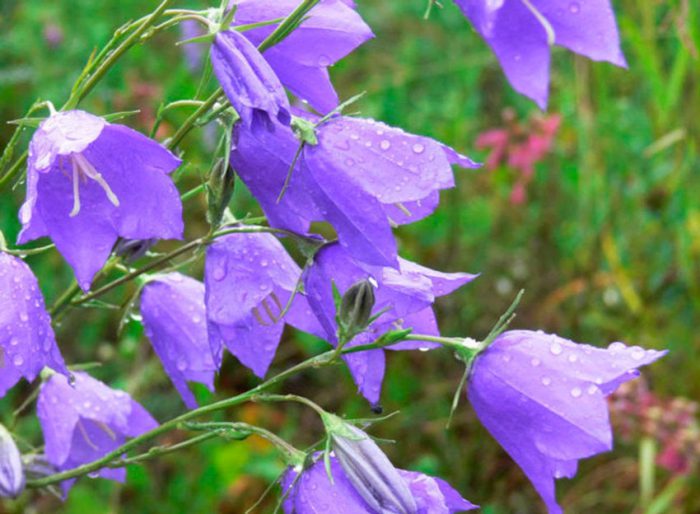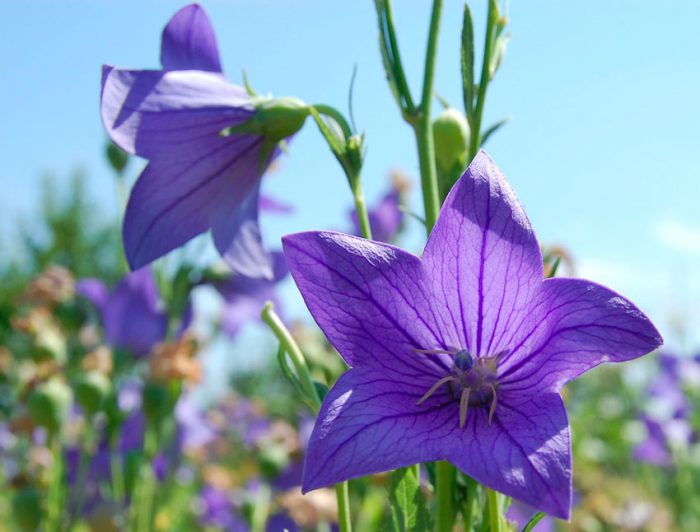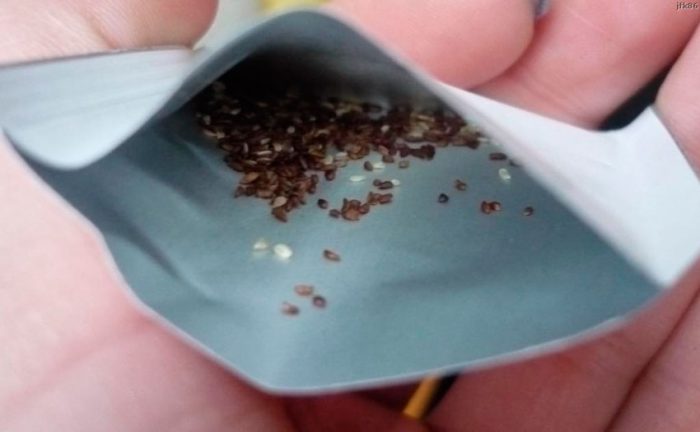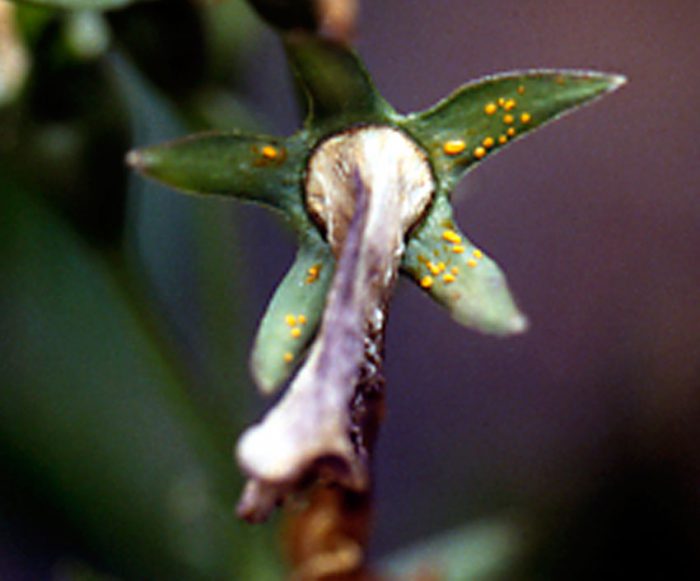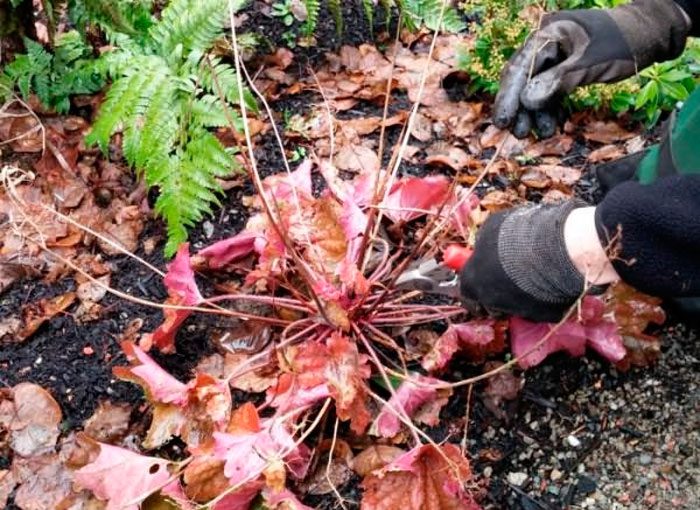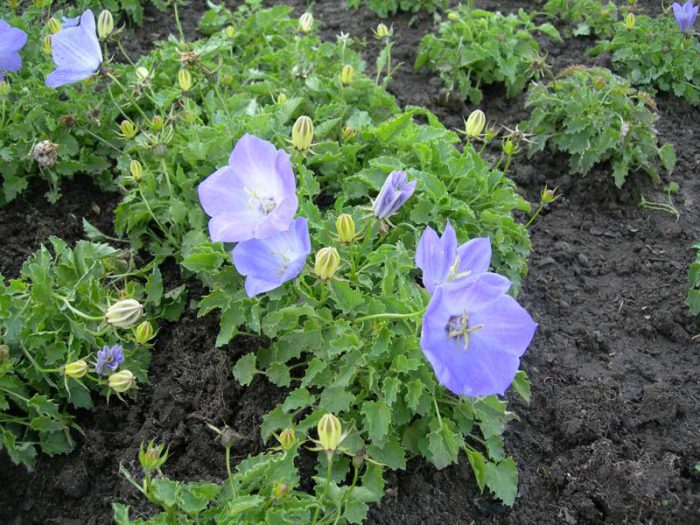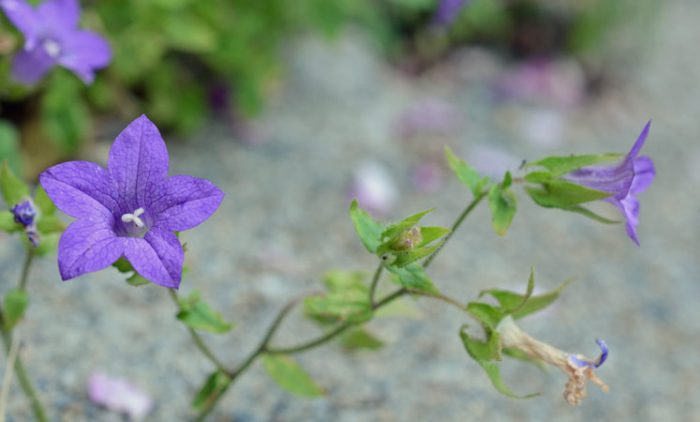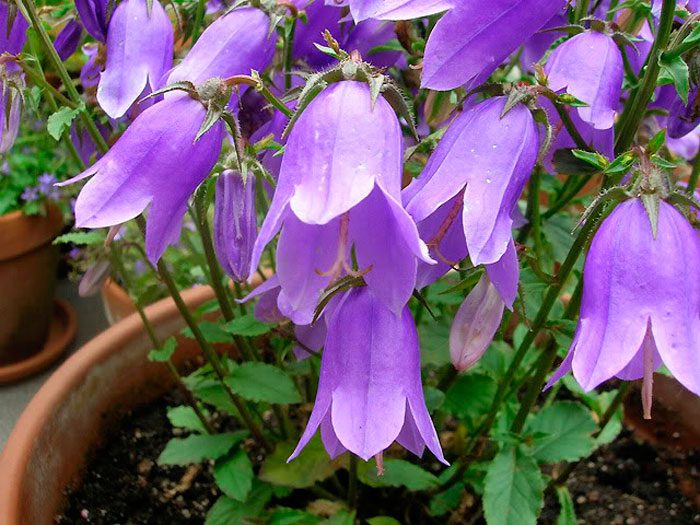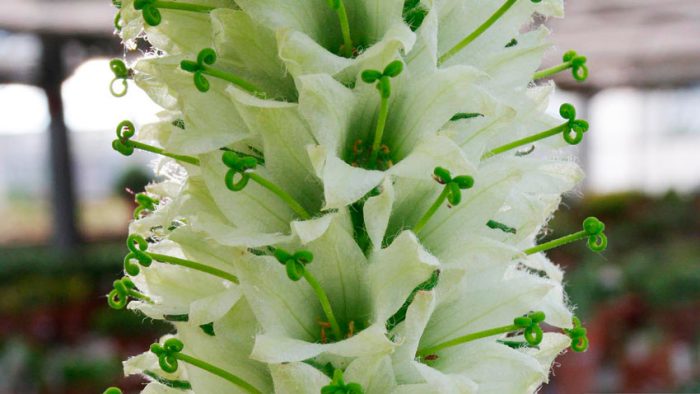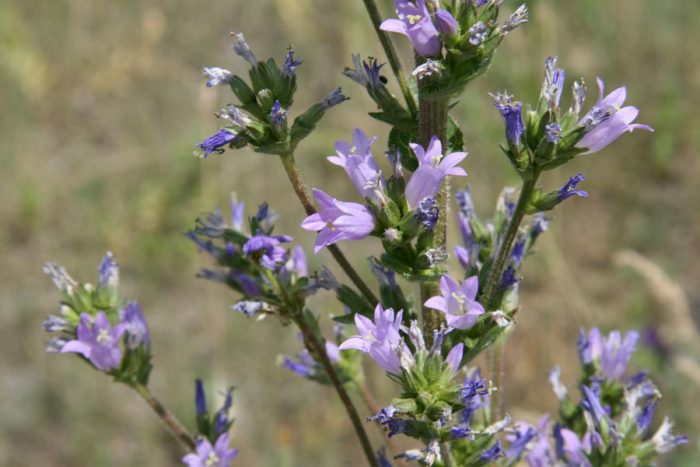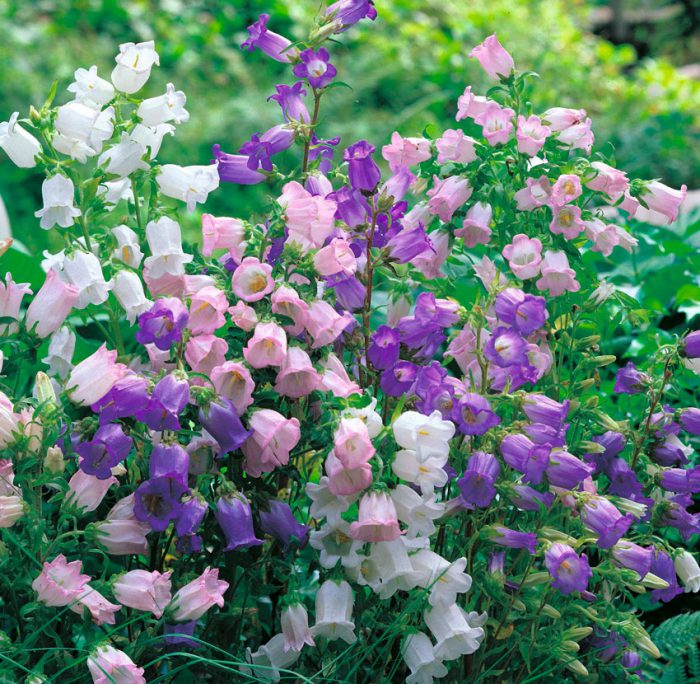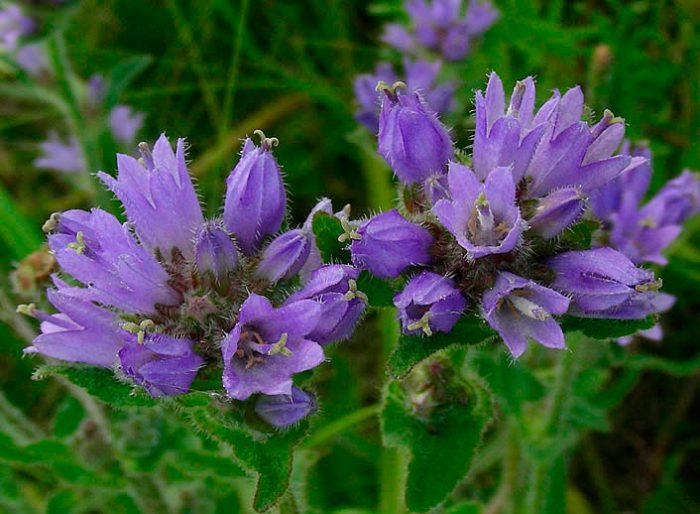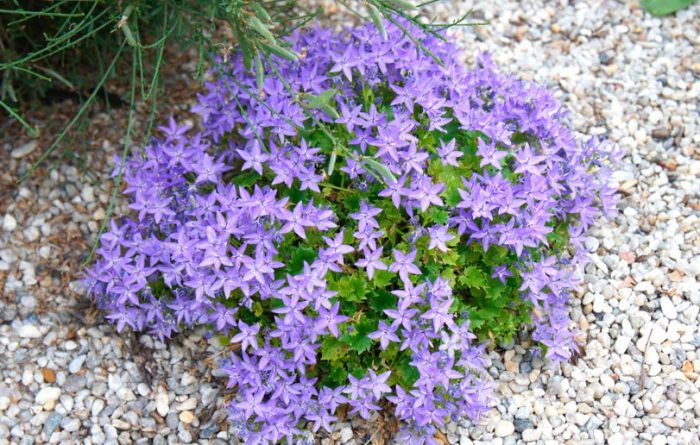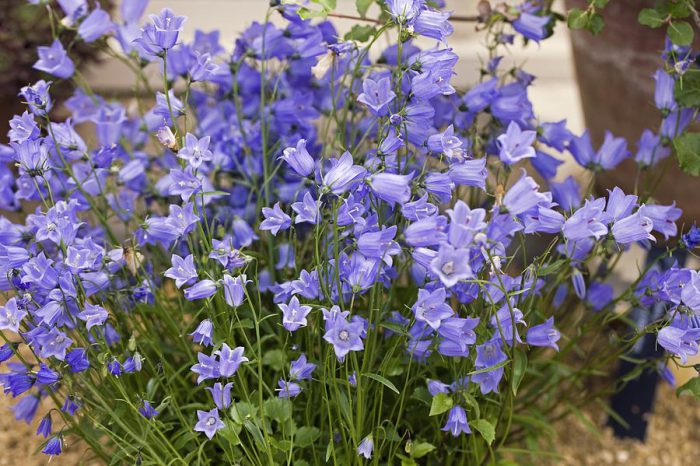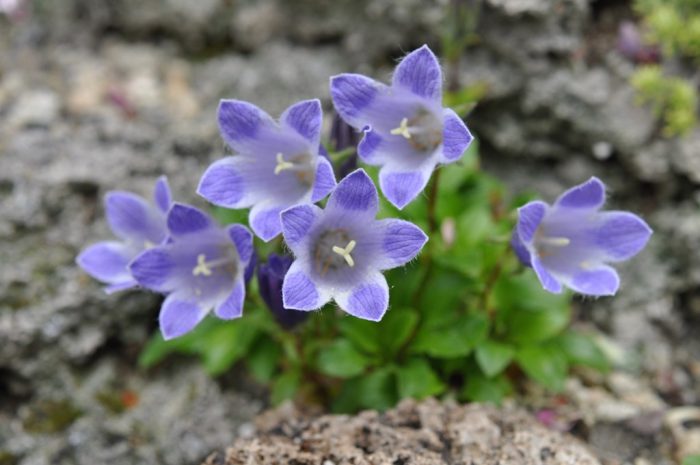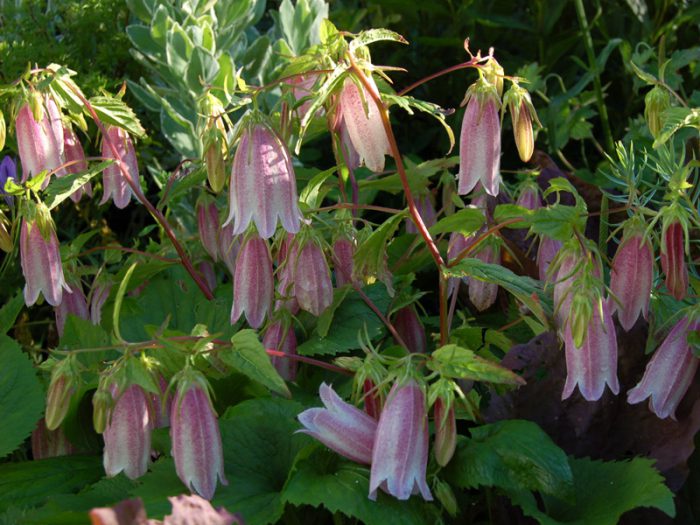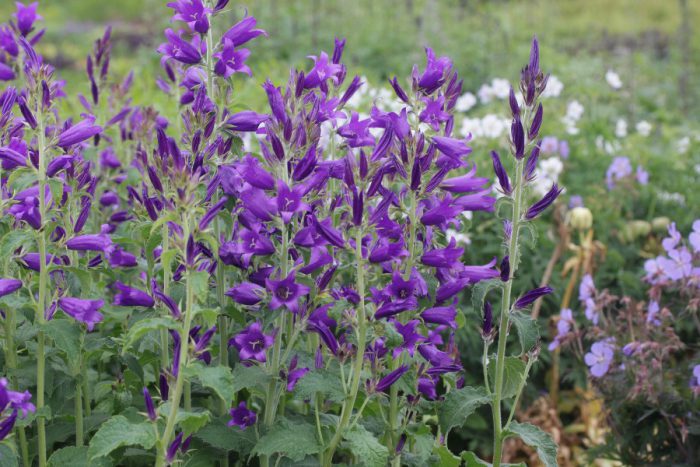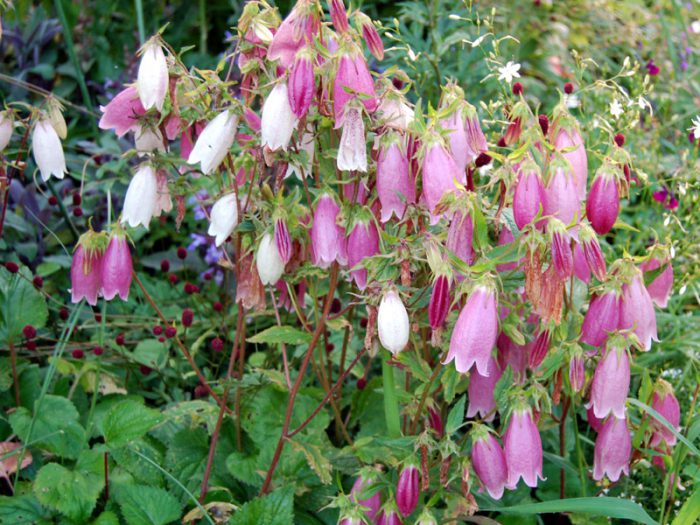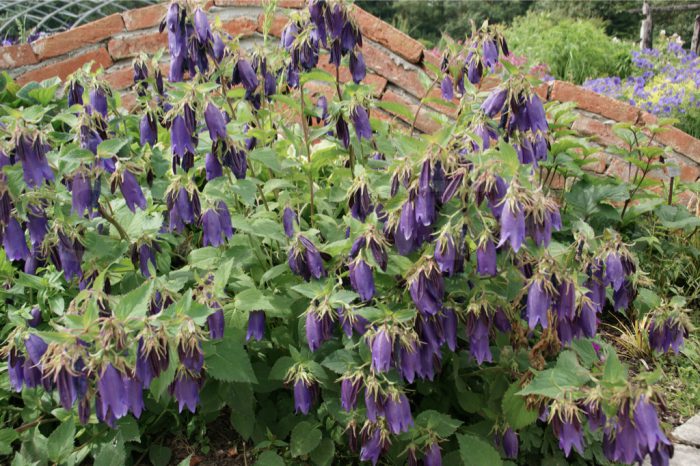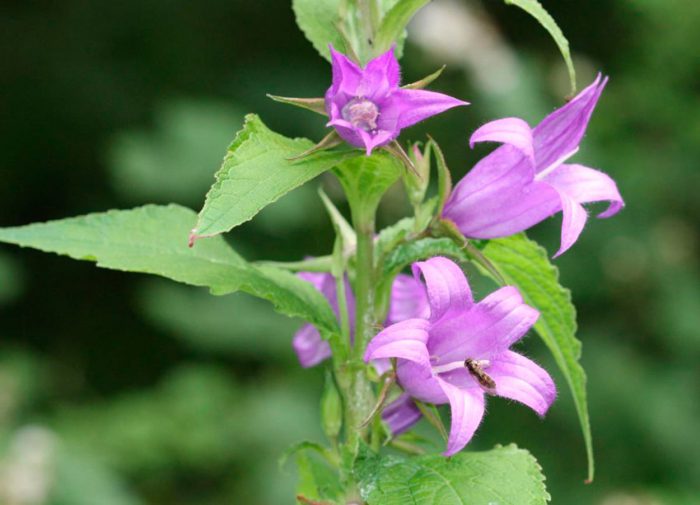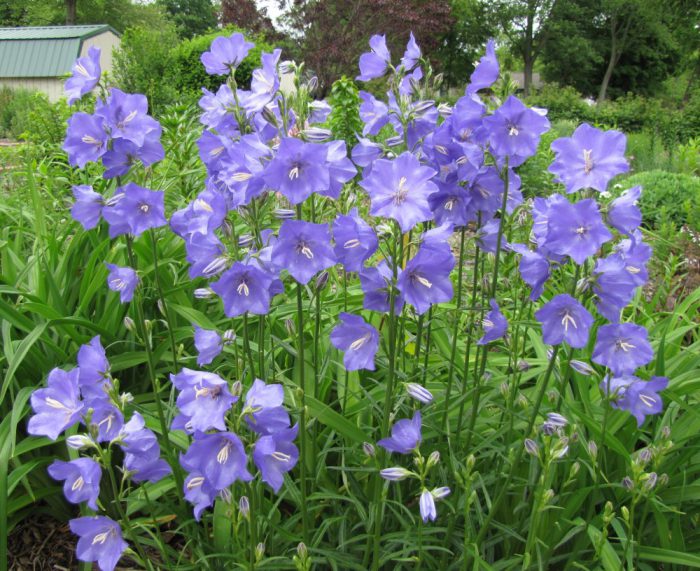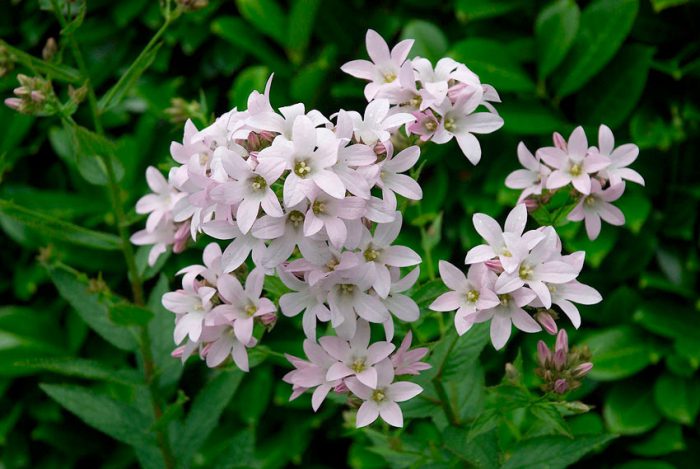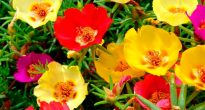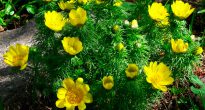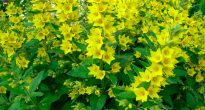Bells (Campanula) are herbaceous plants belonging to the campanula family. This genus unites more than 300 species. Under natural conditions, it can be found in areas with a temperate climate: in Central and Western Asia, in Siberia, in the Caucasus, in Europe and in North America. They grow best in steppes, meadows, rocks, desert areas, and also in the forest. Most types of bells can be found in the subalpine as well as alpine mountain belts. The name of a flower is translated from Latin as a bell. And among the people it is also called chebotki, chenille and bells.
Content
Bells features
Perennial bells are most common, but one- and two-year-olds are also found. On the stems are alternate leaves. The flowers have a bell-shaped shape and are painted in white, bluish color, as well as in various color shades of purple. They are part of racemose or panicle inflorescences. There are also single flowers. The fruit has a head start to the capsule, on which there are 4–6 slit-shaped holes. The bush can be low, medium and tall.
Growing bells from seeds
How to sow correctly
Such seeds do not need to be prepared before planting. They are sown in open soil in the month of May, and can also be sown in October before winter. If you have a desire to admire the blooming bells in a given year, then they should be sown for seedlings in March. It should be noted that the seeds are very small, so they are only scattered over the surface of the prepared soil, which should be loose, light and pass water well. Before sowing, it must be thoroughly moistened in advance. The soil mixture should consist of 6 parts of sod land, of 3 parts of humus land and of 1 part of coarse sand. You should not fertilize the soil.After sowing, the seeds need only be lightly pressed into the substrate and slightly moistened with a spray bottle. Cover the container with a transparent film on top. Such crops should be placed in a warm (18 to 20 degrees) place. The emergence of seedlings, as a rule, occurs after 14–20 days.
Seedling care
After the first seedlings appear, the shelter will need to be removed. Move the container to a well-lit place, but the plants need to be protected from direct sunlight. It is necessary to take care of these plants, like any other seedlings of flowers. They need to ensure timely watering after the top layer of the substrate dries, and it also needs to be loosened regularly. 20 days after the seedlings sprout, real leaves should grow in them, after which they must be dived into a container of a larger volume, keeping a distance of 10 centimeters between the plants. After half a month after you transplant the bells, fertilization will need to be applied to the soil. Liquid complex fertilizer in low concentration is excellent for this purpose.
Planting bells in open ground
At what time do seedlings are planted in the ground
As a rule, grown bells can be planted in open soil either in the last days of May or in the first days of June. Most types of such flowers are light-loving plants. There are also shade-loving species, but extremely rare, they stand out for their foliage of a dark green color. Such a plant does not tolerate drafts.
The choice of soil is necessary depending on the type. So, some grow well on calcareous soil, while others on rocky soil. But most species grow best on neutral or slightly alkaline loamy soil that is well drained. Before you start planting, the soil must be prepared. With deep digging, humus or sand must be added to heavy soil. If the soil is poor, then sod soil and fertilizers must be added to it. However, the use of peat and fresh manure is not recommended, as this can cause the development of a fungal disease.
Rules for planting seedlings in the ground
For planting, you should choose an open place, no shrubs or trees should grow next to it. In this case, the root system will receive a sufficient amount of nutrients, as well as water. The distance between the bushes depends on the type of bells. So, between tall species should be left 40-50 centimeters, between medium-sized - 20-30 centimeters, between undersized - from 10 to 15 centimeters. When the plants are planted, the soil around them should be well compacted, and then watering.
Outdoor Bells Care
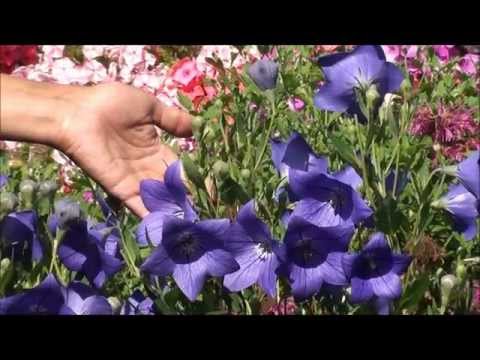

Watch this video on YouTube
Care rules
They must be grown in the same way as other flowers in the garden. Bells are distinguished by their unpretentiousness. Watering is carried out only in the case of a prolonged dry and hot period. To loosen the soil surface and remove weeds, it is recommended after irrigation. If necessary, tall varieties can be tied to a support. The first top dressing is carried out in the spring on melted snow and nitrogen fertilizer is used for this. The second time is fed in the first half of the summer period, when buds begin to form and for this they use a complex fertilizer. Regular removal of wilted flowers will allow the flowering period to be longer.
Reproduction of bells
Annual plants can only be propagated by seeds, and biennial plants can be propagated by seeds, as well as by cuttings in spring. Bells, which are perennials, are propagated: by parts of the rhizome, stolons, root cuttings, and by dividing the bush. Seeds of perennial species may not retain varietal characteristics.In terry varieties, seeds do not appear at all and only a vegetative method is used for reproduction.
Those perennials that have a rod or carpal system of roots are vegetatively immobile, and they are grown exclusively from seeds. Species with a short rhizome are classified as vegetatively inactive, and cuttings and division are used for their reproduction. Species that have creeping long rhizomes are considered vegetatively mobile, and seeds, cuttings, rhizome pieces, root suckers are used for their reproduction, and you can also divide the bush.
Sowing seeds for seedlings is described above. They can also be sown in open soil in mid-October. In winter, they will not freeze out, but will undergo a completely natural stratification. In springtime, you will see dense shoots. After the plants grow up, they will need to be planted. Sowing seeds in open soil can be done in May. But in this case, the seeds will need preparation, or rather, stratification in the refrigerator (in the vegetable drawer), where they should stay for 8 weeks. However, annuals reproduce well by self-sowing, and therefore the difficulties associated with spring sowing can be completely avoided.
Cuttings are harvested in the spring. So, in March or April, you should cut them from young stem or basal stems. For planting, loose and light soil is used. Cover the cuttings with a transparent film so that they are always in high humidity. The ideal option for rooting cuttings is a greenhouse with a mist sprayer. After 3-4 weeks, the cuttings should take root.
As a rule, bushes older than 3-5 years are used for dividing. But there are species that are suitable for division already in the second year of life. It is necessary to dig out large bushes in the first days of May or at the end of the summer period. They cut off all the shoots, and then divide the rhizome into parts using a very sharp pre-sterilized knife. Make sure that renewal buds and well-developed roots are present on each section. Sections must be processed with chopped charcoal, and then immediately plant the cuttings in a permanent place.
In order to propagate by parts of the roots, you need to dig out the creeping rhizome and cut it into pieces. Please note that each such division must have a renewal bud. Then they are planted in the soil so that the buds are at the level of the soil surface.
The root offspring separated from the mother plant is immediately planted in a permanent place.
Pests and diseases
Bells have a very beautiful appearance and are distinguished by their unpretentiousness. These plants are highly resistant to diseases and harmful insects and get sick in very rare cases. But if perennials are grown for a long time without transplanting, then the accumulation of pathogens (sclerotinia, fusarium or botrytis) can occur in the soil, which can completely destroy the bells. In order to avoid this, it is necessary in the spring and autumn to carry out one treatment of plants with a solution of Fundazol (0.2%).
A slobbering penny can appear on bushes in wet weather. Infected plants are treated with garlic infusion. Low-growing species can be affected by slugs. In this case, processing is carried out with a decoction of hot pepper, and granular superphosphate must be scattered over the surface of the soil.
Perennial bells after flowering
What time and how to collect seeds
If you decide to collect seeds from the bells, then you need to cut the pods after they turn brown, and do not wait until they open. Place the cut pods in a dry and ventilated place and wait for the seeds to ripen.
Preparation for wintering
Perennials, in contrast to one-year-olds and two-year-olds, must be prepared for wintering.In the last September or first October days, you will need to cut off all the shoots at the root. After that, you no longer need to care for annuals. Perennials and biennials, as a rule, can survive the winter without shelter, however, southern species must be sprinkled with spruce branches or dried leaves. Tall species should be sprinkled with dry peat or humus, while the layer should have a thickness of 15 to 20 centimeters.
Types and varieties of bells with photo
Annuals are usually southern plants. In this regard, gardeners rarely grow them in places with cool or temperate climates. The most popular are:
Annual bells
Such a plant is undersized and its bush does not exceed 10 centimeters. His homeland is the Balkans, Asia Minor, the Caucasus and the Mediterranean. The tubular corolla is colored deep blue. Flowering begins in May and ends early in the fall. They are decorated with rock gardens and borders.
Dichotomous bell (forked)
Homeland is the Western Caucasus. The bush grows up to 15–20 centimeters in height. There are broadly ovate leaves, as well as a large number of pale purple flowers.
Bell kashmir
Originally from the Pamirs and the Himalayas. The height of the bush does not exceed 6-8 centimeters. Small, numerous purple flowers reach one and a half centimeters in length. Long flowering.
Long-columnar bell
It is endemic to the Caucasus. It prefers to grow in rocky crevices and on gravelly ground. The height of the strongly branching bush is 50 centimeters. Flowering is observed from May to July. Inflorescences in the form of panicles consist of 50-60 flowers, which have a bell-shaped pitcher and purple color. Their diameter is 4 centimeters, the base is inflated, and the calyx has pointed deflected teeth.
Bell Mirror Venus
Homeland are Mediterranean mountains, from Holland and Great Britain. It has been cultivated since the end of the 16th century. The height of the bush varies from 15 to 30 centimeters. Inflorescences in the form of panicles consist of saucer-shaped flowers with a diameter of two centimeters. They are painted blue with a lilac sheen and have a whitish middle. Flowering is observed from early May to September. There are varieties with white flowers.
Biennial bells
Bearded bell
Originally from the subalpine belt of the Mediterranean. The height of the bush varies from 4 to 30 centimeters. The drooping light blue flowers are bell-shaped and three centimeters long. Flowering is observed from June to July. Grown since 1752
Hoffman's bell
Homeland of the Adriatic and the Balkans. The height of a highly branching bush varies from 30 to 50 centimeters. There are many large drooping flowers, painted in cream or white. Bloom - from June to July.
Thyrsoid bell and spiky bell
The spike-shaped inflorescence consists of funnel-shaped flowers. In Thyrsoid bells, they are pale yellow, and in spicates, they are deep purple.
Large-ear bell
Originally from Europe, the Balkans and Asia Minor. The height of the bush varies from 70 to 120 centimeters. Light purple tubular corollas are part of whorls (6 or 7 flowers). Flowering begins in June or July.
Bell middle
Homeland Asia and Southwest Europe. This biennial plant is grown in some cases as an annual. The height of its erect shoots is 50–100 centimeters. Pyramidal inflorescences consist of double or simple bell-shaped flowers, seven centimeters long and blue, white or light pink in color. Grown since 1578
Bellflower haired
His homeland is Siberia and Europe. Such a bush has dense pubescence, and its height varies from 70 to 100 centimeters. Sitting little flowers are blue.They are part of the inflorescence, which has an almost capitate upper part and a whorled - lower one.
You can also meet such biennials as: Siberian, spreading, laurel, spatulate, Orphanidea, Mesian, diverging, pyramidal, Formanek and Sartori.
All remaining species are perennial and are divided into high, medium and low growing.
Low-growing species of perennial bells
Carpathian bell
The most popular among gardeners and its homeland are the mountains of Central Europe and the Carpathians. A bush with leafy shoots reaches a height of 30 centimeters. Basal rosette consists of long-petiolate ovoid leaves. There are also ovoid stem leaves with short petioles. Single bell-funnel-shaped flowers have a five-centimeter diameter, and they are painted in purple, blue or white. Flowering begins in June and lasts over 8 weeks. Grown since 1770
Popular varieties:
- White Star and Alba - white flowers;
- Isabelle and Celestina - flowers of sky-blue color;
- Riversley, Chenton Joy, Blaumeise - blue flowers;
- Carpatenkrone - purple flowers;
- Clip - the height of the bush does not exceed 20 centimeters, and the flowers have a five centimeter diameter. Can be grown in the garden and at home.
Gargan bell
The bush reaches a height of only 15 centimeters. It has creeping, ascending shoots that are quite fragile. Three-toothed leaves have a rounded shape. The flowers are star-shaped with a four-centimeter diameter and are colored blue. Grown since 1832
Most popular varieties:
- Major - light blue flowers;
- H. Paine - Pale lavender flowers have a whitish eye.
Spiral-leaved bell (spoon-leaved)
Originally from the Alps and Carpathians, the height of the bush does not exceed 15 centimeters. Creeping shoots. Small inflorescences consist of small (1 centimeter in diameter) drooping flowers, painted in blue, blue or white. Grown since 1783
Most popular varieties:
- Alba - white flowers;
- Loder - double blue flowers;
- Miss Wilmott - blue flowers.
Bell Shamiso
The homeland of such a miniature bell is the Far East. Single flowers with a three-centimeter diameter in length reach 4 centimeters and have a bluish-purple color. The rim stands out with a shaggy edge. There is a variety with white flowers.
And there are also such undersized perennials as: hairy, saxifrage, daisy-leaved, Osh, povoynichkovy, Radde, ciliate, darkish, Uemura, birch-leaved, turfy, Kemularia, one-flowered, Ortana, borderline, Rainer, dark and three-toothed.
Perennials of medium height
Bell of Takeshima
Homeland Iranian Highlands and Korea, the bush does not exceed 60 centimeters in height and it has a group of basal rosettes. This species has many shoots that can be creeping, ascending and creeping. Flowering begins in June. There are double or simple flowers, painted in white, blue or pink.
Popular varieties:
- Beautyful Trust - large spider-like flowers are painted white;
- Wedding Belz - bell-shaped double flowers are whitish in color.
Komarov's bell
It is endemic to the Caucasus, very spectacular branching shoots are no more than 45 centimeters high. There are many large flowers in a rich pale purple hue. They are three centimeters long and have turned down pointed lobes.
Point bell
Homeland Siberia and the Far East, a thin fibrous shoot has a half-meter height. Many hairy leaf plates are found in the root areas. They are located on reddish petioles. The shape of the leaves is ovoid, pointed or lanceolate. Large pubescent drooping flowers have a bell-goblet shape.Their pedicels are long, and they are painted in an off-white shade, while on the surface there are purple dots both outside and on the inner surface.
Popular varieties:
- Rubra - flowers of a rich color;
- Alba nana - the height of the bush is about 20 centimeters, the color of the flowers is white.
Bell Sarastro
This is a hybrid of a dotted bell, seven centimeters long flowers have a rich purple color. The bush has a height of up to 60 centimeters, and its diameter is up to 45 centimeters.
Also, middle-sized perennials include a polymorphic bell, Moravian, Spanish, karnica, round-leaved, mound, Sarmatian, Grosseka, Tatra, rhomboidal, flax-leaved, wonderful, Marhesetti, perforated, garlic, Belly-leaved, pale-ocherous, and Pinkupinch.
Tall perennials
Broadleaf bell
Homeland Central and Southern Europe, Asia Minor, the European part of Russia, the Caucasus, Siberia, Ukraine. It is found in dark coniferous, broad-leaved, as well as mixed forests and on river banks. The bare straight shoot is one meter high. The length of the bare double-serrate leaf plates is 12 centimeters, and the width is 6 centimeters. There are large axillary flowers, which are part of a narrow, rare-flowered spike-shaped brush. The length of the flowers is about 6 centimeters. They are funnel-shaped and white, blue or blue in color. Bloom is observed from June to August. Grown since 1576
Popular varieties:
- Alba - white flowers;
- Brantwood - purple flowers;
- Makranta - large flowers of dark purple color.
Bell peach
Homeland Western Siberia, Ukraine, the Caucasus, the European part of Russia, Western Europe. The height of erect leafy shoots varies from half a meter to a meter. Smooth, serrated leaf plates are similar to peach foliage. Large flowers with a wide bell-shaped shape are five centimeters long. They are colored blue, white or bluish-lilac. Paniculate inflorescences consist of several flowers. There are double and crown varieties. Blooms from mid-June and blooms for over 4 weeks. Grown since 1554
Popular varieties:
- Bernice - terry blue flowers;
- Tetam Beauty - large flowers of a pale blue color;
- Exmaus - double flowers have a dusty blue color;
- Snowdrift - white flowers;
- variety mixture New Giant Hybridz - the height of the bush is no more than 75 centimeters, large flowers are painted in white and various shades of blue.
Bellflower milky-flowered
Homeland Caucasus and Asia Minor. The height of the bush varies from 0.5 to 1.5 meters. Thanks to the rod rhizome, it can grow on loamy heavy soil. Milky white bell-shaped flowers are four centimeters in diameter. They are collected in brush-shaped inflorescences. Flowering begins in June and ends at the end of the summer period. Grown since 1814
Popular varieties:
- Cerulea - bluish flowers;
- Alba - white flowers;
- Pritchard Verayeti - blue lavender flowers flaunt on a one and a half meter bush.
There are also such tall species as: crowded, noble-large-flowered, rapunzel, bologna and nettle-leaved.

